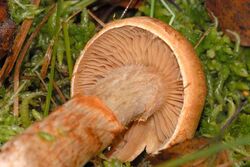Biology:Cortinarius armillatus
| Cortinarius armillatus | |
|---|---|

| |

| |
| Scientific classification | |
| Domain: | Eukaryota |
| Kingdom: | Fungi |
| Division: | Basidiomycota |
| Class: | Agaricomycetes |
| Order: | Agaricales |
| Family: | Cortinariaceae |
| Genus: | Cortinarius |
| Species: | C. armillatus
|
| Binomial name | |
| Cortinarius armillatus | |
Cortinarius armillatus, commonly known as the red-banded cortinarius or bracelet cortinarius,[1] is a late summer and autumn (as late as in October) fungus usually found in moist coniferous forests, especially spruced ones. The species grows rarely in North America, but is common in Europe.
Elias Magnus Fries described the species in 1838.[2]
The cap is bell shaped at first, later flattening out, vividly rust-brown becoming slightly paler with age, with small fibrous scales. The cap grows from 5 to 15 cm in diameter. The gills are dark rust-brown; broad, distant and shallowly sinuate. The spores are also rust-brown. The flesh is light brown.
Uses
The species is considered either edible but mediocre[3] or inedible.[4] The fruit body has been found to contain orellanine, though at much lower concentrations than the lethal webcaps.[5]
When dyeing cloths, without added metals, it discharges pink, with tin yellow, with copper green and with iron olivic dyes.
References
| Cortinarius armillatus | |
|---|---|
| Mycological characteristics | |
| gills on hymenium | |
| cap is campanulate or convex | |
| hymenium is adnate or sinuate | |
| stipe has a cortina | |
| spore print is brown | |
| ecology is mycorrhizal | |
| edibility: not recommended | |
- ↑ Arora, David (1986). Mushrooms demystified: a comprehensive guide to the fleshy fungi (Second ed.). Berkeley: Ten Speed Press. pp. 448–449. ISBN 978-0-89815-169-5.
- ↑ Cortinarius armillatus in MycoBank.
- ↑ Miller Jr., Orson K.; Miller, Hope H. (2006). North American Mushrooms: A Field Guide to Edible and Inedible Fungi. Guilford, CN: FalconGuide. pp. 313. ISBN 978-0-7627-3109-1.
- ↑ Phillips, Roger (2010). Mushrooms and Other Fungi of North America. Buffalo, NY: Firefly Books. p. 180. ISBN 978-1-55407-651-2.
- ↑ "A novel orellanine containing mushroom Cortinarius armillatus". Toxicon 114: 65–74. 2016. doi:10.1016/j.toxicon.2016.02.010. PMID 26915341.
External links
Wikidata ☰ Q1517961 entry
 |

